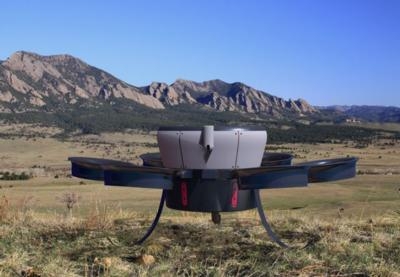Awards COA To Collaborative Effort For Two Types Of Aircraft Up To 15,000 Feet
A collaborative effort involving six counties, the University of Colorado Boulder and the nonprofit aerospace advocacy group, UAS Colorado, has paved the way for the launch and testing of two unmanned aircraft systems (UAS) in the San Luis Valley.

The FAA has awarded two Certificates of Authorization (COA) for the aircraft to fly in an 8,000-square-mile air space in the San Luis Valley to heights of 15,000 feet. San Luis Valley’s Leach Airport in Center, Colorado, will be the primary operations hub for UAS testing in the valley, with participation by number of other airports scattered across the valley, said Alamosa County Attorney Jason Kelly.
The FAA has approved two types of UAS for flight there: a 120-pound vertical takeoff craft known as the Reference Technologies Hummingbird (pictured) and a smaller, battery-powered UAS that is being developed jointly by Black Swift Technologies and Swift Engineering and which can be hand-launched with a payload of up to 8 pounds. Reference Technologies Inc. is headquartered in Lafayette, Colorado, while Black Swift Technologies, headquartered in Boulder, is a start-up company founded by CU-Boulder alumni Jack Elston, Maciej Stachura and Cory Dixon.
According to CU-Boulder aerospace engineering sciences Professor Brian Argrow, the collaborative effort to obtain the San Luis Valley air space from the FAA involved working closely with air traffic controllers at the Denver Air Route Traffic Control Center in Longmont to enable the UAS flights to be cleared up to 15,000 feet. “We see this as a major accomplishment for UAS operations in Colorado,” said Argrow.
“The decision by the FAA to allow for the testing of UAS aircraft in the San Luis Valley is a big step forward in keeping Colorado at the forefront in the development and testing of these aircraft,” said UAS Colorado CEO Constantin Diehl, who formally submitted the two COA applications requesting the San Luis Valley airspace.
In 2012, Argrow led the CU portion of an effort for Colorado to acquire one of six FAA test sites for UAS. While Colorado was not selected, the proposal galvanized a statewide effort to acquire a test site that was heavily supported by the Metro Denver Economic Development Corp., the Adams County Economic Development Corp. and several state-based companies and individuals, said Argrow.
UAS Colorado represents a statewide business league of more than 100 industry, research and economic development stakeholders dedicated to preserving Colorado’s leading role in the UAS aerospace industry. Diehl also is the CEO of Rocky Mountain UAS, created in 2013 to partner with CU-Boulder on research efforts.
In September, CU-Boulder announced university-wide “Grand Challenge” to build on strengths of the institution in aerospace-related science and technology. As part of the Grand Challenge, CU-Boulder is investing $2 million in a new initiative called the Integrated Remote and In Situ Sensing Initiative (IRISS) to use UAS, or drones, to enhance research data collection from the ground, in the atmosphere and in space.
According to Argrow, UAS have the potential to be used for a wide variety of projects ranging from crop and drought monitoring and power line and pipeline inspection to search and rescue operations, firefighting support and airborne delivery activities.
Black Swift Technologies and CU-Boulder, for example, recently completed the successful flight of a Tempest UAS carrying instruments to measure soil moisture, a project supported by a NASA Small Business Innovation Research Program. The technology could have far-reaching applications ranging from drought assessment and flood forecasting to water conservation.
Operating one of the comprehensive UAS research programs in the nation, CU-Boulder has undertaken projects ranging from monitoring seal populations in the Arctic and charting sea ice changes near Greenland to intercepting storm cells associated with tornadoes in Colorado, Kansas and Nebraska and measuring gaping holes in Antarctic sea ice.
(Image provided with University of Colorado news release)
 ANN's Daily Aero-Term (04.24.24): Runway Lead-in Light System
ANN's Daily Aero-Term (04.24.24): Runway Lead-in Light System ANN's Daily Aero-Linx (04.24.24)
ANN's Daily Aero-Linx (04.24.24) Aero-FAQ: Dave Juwel's Aviation Marketing Stories -- ITBOA BNITBOB
Aero-FAQ: Dave Juwel's Aviation Marketing Stories -- ITBOA BNITBOB Classic Aero-TV: Best Seat in The House -- 'Inside' The AeroShell Aerobatic Team
Classic Aero-TV: Best Seat in The House -- 'Inside' The AeroShell Aerobatic Team Airborne Affordable Flyers 04.18.24: CarbonCub UL, Fisher, Affordable Flyer Expo
Airborne Affordable Flyers 04.18.24: CarbonCub UL, Fisher, Affordable Flyer Expo



